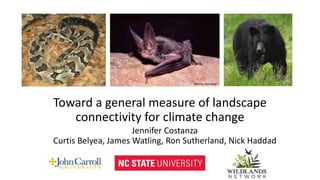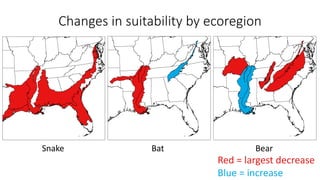Toward a general measure of landscape connectivity for climate change
- 1. Toward a general measure of landscape connectivity for climate change Jennifer Costanza Curtis Belyea, James Watling, Ron Sutherland, Nick Haddad
- 2. Biological Conservation 142 (2009) 14-32 Increasing connectivity consistently ranks as the most popular strategy for climate change 2009, Biological Conservation
- 3. Big, bold plans for landscape connectivity are emerging Theobald et al. 2012 Conserv.Lett.WA Connected Landscapes Project
- 4. Courtesy of Ron SutherlandFrom the Wildlands Network Connectivity planning in the Southeast
- 5. Black bear (Ursus americanus) Rafinesque’s big-eared bat (Corynorhinus rafinesquii) Timber rattlesnake (Crotalus horridus) Approach: connectivity for multiple species
- 6. Research questions • Where are the most and least threatened connections for each species? • Do species vary in the climate change threat to their connectivity?
- 7. Alternative resistance surfaces Niche model Empirical (literature) Red High resistance Blue Low resistance Expert opinion (surveys) Black bear
- 8. Mapping connectivity Resistance surface Habitat nodes Connections Linkage Mapper software: least-cost paths between nodes
- 9. Future threat is change in suitability Black bear percent change in suitability recent to 2050, A2 scenario Red Decrease Blue Increase
- 10. Red Large decrease Orange Moderate decrease Blue Increase Black bear niche resistance, Linkage Mapper Change in habitat suitability
- 12. BatSnake Bear Changes in suitability by ecoregion Red = largest decrease Blue = increase
- 13. Which links connect to important nodes? Change in Integral Index of Connectivity for nodes (Pascual-Hortal and Saura 2006) Dark blue = 10% most important nodes Black bear
- 14. Where are the important links that are most and least threatened? BatSnake Bear Red = 10% most threat Blue = 10% least threat
- 15. Summary • We mapped climate change threat to habitat connections for three species in the Southeast • On average, suitability decreased within mapped connections, and species were similar in average amount of climate change threat • The geography of climate change threat varied by species • We are doing parallel work to examine effects of future land use change on connections















